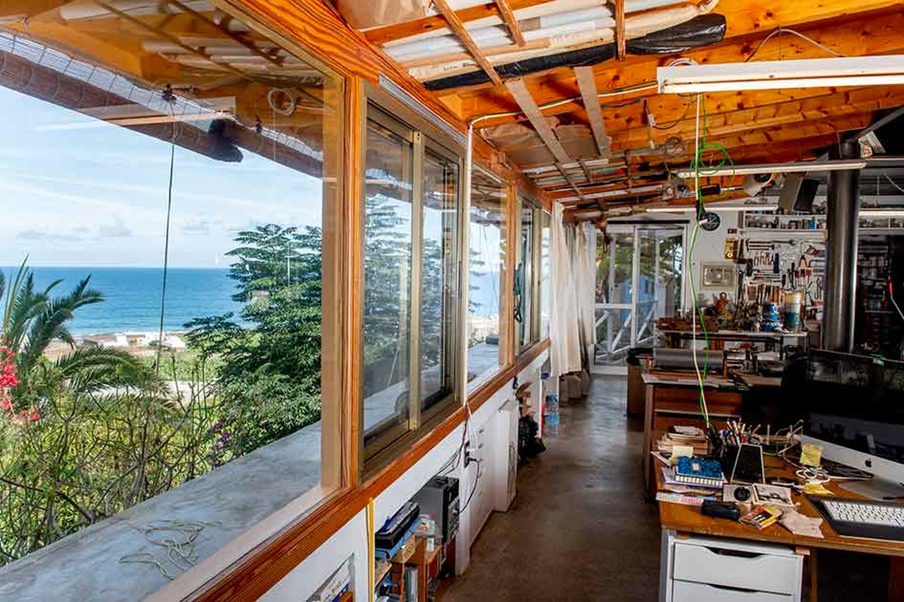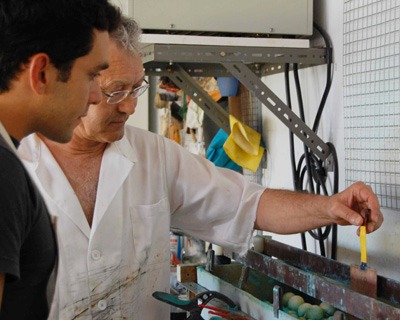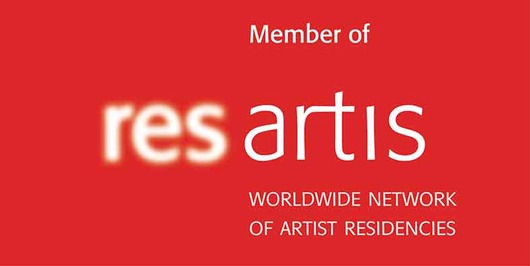• International open call to attend the residence in 2024-2025
More information about rates, please send an e-amail to: electro@crujera.com . Download the Registration Form.
• Artists in residence in 2025
• June Anđela Rončevic, Printmaker, illustrator, ceramist. Croatia. instagram: andela_crta
• July Josh Weiss, printmaker. USA.
• October Bernhard Cociancig, printmaker. Austria
• See Artists in residence from 2024 - 2011

Introduction
The Electro-etching residency introduces the artist to an alternative technique of intaglio etching, using a completely non-toxic electrical process, and thus avoiding the harmful acids used in traditional etching. The electro-etching residency is held at the workshop and residence of the artist Alfonso Crujera, a master printmaker and specialist in the varied techniques of etching with electrolysis.
About Electro Etching
Today many etchers face growing concern with respect to the highly toxic nature of their craft. As a result, they have started to experiment with new products, new resists and mordents and have begun to discover how to modernise and improve upon traditional techniques.
It is usual now to hear of “non-toxic” or “low-risk” etching, where acids are replaced with salts and asphalt resists are replaced with non-toxic acrylic or oil-based resists. These substitutes (and lots more) create a wide range of low-risk materials and techniques that can transform the workspace into a safe and clean environment, free from dangerous substances.
One of these processes, electro-etching, is in fact a practically unknown and overlooked technique from the 19th Century. It is currently one of the most attractive, innovative, and practical methods of etching copper, zinc, or iron plates, minimising the risks for both the etcher and the environment. The electro-etching process does not generate toxic gases, nor does it produce residues. The mordents do not become exhausted by successive bites and neither toxic rosin nor asphalt is used for aquatint.

About Alfonso Crujera
Since 2001, when he was first introduced to the technique of electro-etching at Atelje Larsen in Helsinborg, Sweden, Alfonso Crujera (Seville, 1951) has devoted his creative time to experimenting with this new technique. The knowledge and experience gained as a result of his extensive research and practice in the field, has been shared by him in conferences and courses on electro-etching at universities and workshops. He has published a manual and numerous articles outlining the diverse processes of etching using electrolysis. His expertise has been in demand in both Spain and Mexico, where he has given advice on how to setup electro-etching units in workshops and specialist courses.
The location
The non-toxic workshop and residency of the artist, Alfonso Crujera, is held on the north coast of the island of Gran Canaria, Spain. It is 700 metres from the neighbourhood of San Felipe, which boasts tidal swimming pools, restaurants, and a beach ideal for surfing.
The residence is a traditional coastal farmhouse, lovingly restored by the artist. The print workshop is 70m² and has an adjoining private studio apartment available for the resident artist. It is located on the slopes of a beautiful ravine, abundant with plants native to the Canary Islands. From the natural-light studio, the residence and the balconies, you can enjoy the magnificent panorama of the sea and surrounding farmland. The area enjoys a very pleasant and moderate sub-tropical climate all year round, with average temperatures ranging between 12-28ºC.
In this natural environment, perfect for reflection and creativity, the artist has transformed the workshop into a workspace that is free from toxic emissions and respectful to the environment.
Duration of residency
From two weeks to one month.
During the Residency
The resident artists will be introduced to the fascinating process of electro-etching copper and zinc plates instead of using traditional acids. They will have access to the master’s direct and personal assistance and will have the opportunity to develop upon their current knowledge of non-toxic etching using electricity and applying these techniques to their own work. The artists will also learn how to assemble an electro-etching unit themselves, so they will be able to continue electro-etching in their own studio back home.
The workshop is available to the resident-artists round the clock.
Theoretical content
• Rudiments of electrolysis
• History of electro-etching
• Principles of electro-etching
• The electro-etching unit.
• How set up an electro-etching unit from scratch
(You do not need any previous knowledge of electricity)
• Preparing the electrolyte
• Voltage and amperage
Practical content
• Preparation of the plate, including filing and degreasing
• Hard ground, etching lines
• Electrotint with open bite
• Resists made with graphite ink
• Soft ground
• Deep bite with passive electrolysis
• Semi-dry electro-etching
• Alternative resists (lithographic pencil, oxidation, splashing, electroplate, etc.)
• Galvanizing lines and electrotint
• Galvanography
• Safety rules
Language: English and Spanish
• Artists from Argentina, Australia, Austria, Belgium, Brazil, Canada, Costa Rica, Cuba, Estonia, Italy, Mexico, Paraguay, Poland, Spain, South Korea, UK and USA, have already attended this electro-etching workshop-residence.
• This workshop-residency is a private organization, and we do not provide grants to the artists. The artists must secure their own funding. The Residency is happy to assist artists seeking grants by providing a letter of invitation.*
* If you are a citizen of Europe you can also apply for funds to the Culture Moves Europe Individual Mobility Action supported by the Goethe Institut. Until 30-11-2024
• See Artists in residence from 2024 - 2011
• Pictures from the Residency and Location
International open call for applications to attend the residency in 2022 - 2033
For more details about the residence, please send an e-mail to: electro@crujera.com
Download the Registration Form.
* However, this residency-workshop offers each year two individual grants for two artists under thirty with a degree in Fine Arts or printmaking. The call is published on our website every year between September and December.
• Artist awarded in 2024. Bach Singh (England), and Quirina Wang (China)
• Artist awarded in 2023. Hannah Feuerstein (Germany / Scotland)
• Artist awarded in 2022. Kailey Mackenzie Brown (USA)
• Artists awarded in 2019. Kristina Key (USA), and Carissa Kalia Heinrichs (USA)
• Artists awarded in 2018. Anna Ólafsson (Scotland / UK), and Diego Vergara Mesa (Colombia / USA)
• Artists awarded in 2017. Laura Bollati (Italy), and Cara Seccafien (Canada).
• More information about the artists in residence. Years: • 2024-2023 • 2023 -2019 • 2019-2018 • 2017-2015 • 2014-2011.
Member of:
Publications about the Electro-etching Workshop-Residence
• Published in Exhibist Magazine, January 2016. Currently posted on Julie Upmeyer's website. Artist Residencies, A Guide to Established Archetypies & New Paradigms, by Julie Upmeyer and Anna Zizlsperger.
• On Places, Rewards, and Negotiations, An Artist’s Venture into Residencies. Published in Exhibist Magazine, January 2016. Currently posted on Julie Upmeyer's website.
• EL TALLER DE ARTE GRÁFICO. Modelos de Espacios de Producción de Arte Gráfico en España 2014. Doctoral thesis by Julia Matute. Universitat Politècnica de Valencia. España. 2015.

